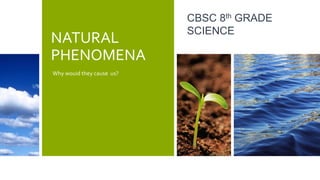
Natural phenomena....pptx
- 1. NATURAL PHENOMENA Why wouid they cause us? CBSC 8th GRADE SCIENCE
- 2. • Rain ,Thunder and Lighting • Light • Night sky • Earthquakes Contents
- 3. What is natural phenomena Natural phenomena refers to observable events or occurrences that happen in the natural world, usually without human intervention or influence. Examples of natural phenomena include weather patterns, geological events such as earthquakes and volcanic eruptions, astronomical events such as eclipses and meteor showers, biological phenomena such as animal migration and plant growth, and physical phenomena such as the formation of crystals and the behavior of light.These phenomena are often studied by scientists and are used to gain a better understanding of the natural world and how it works.
- 4. • Rain is a natural phenomenon that occurs when water vapor in the atmosphere condenses into liquid droplets and falls to the ground.This process is a part of the water cycle, which is the continuous movement of water between the atmosphere, land, and oceans. • Rainfall is caused by several factors, including atmospheric temperature, pressure • Rain plays an important role in the environment by providing water to plants, animals, and humansure, and humidity. Rain in natural phenomena
- 5. Thunder and lightning • Thunder and lightning are natural phenomena that occur in the atmosphere. Lightning is an electrical discharge that occurs between the clouds or between the cloud and the ground, while thunder is the sound produced by the rapid heating and cooling of the air surrounding the lightning bolt. • Lightning is created by the build-up of electrical charges within a cloud. As the charge grows stronger,Third bullet point here • Thunder can be heard up to 10 miles away from the lightning bolt that created it.
- 6. The night sky is a natural phenomenon that has fascinated humans for centuries. It is the expanse of the dark sky above us that is visible at night and contains stars, planets, galaxies, and other celestial objects. • Stars:These are luminous celestial objects that emit their own light and are visible from Earth as tiny points of light in the night sky.They are formed from the collapse of giant clouds of gas and dust. • Aurora: Aurora is a natural light display that occurs in the polar regions of the Earth. It is caused by the interaction of charged particles from the sun with the Earth’s magnetic field and atmosphere • Meteor showers:These are events in which a large number of sky. Night sky Northern Lights: The Northern Lights, also known as the Aurora Borealis, is a natural light display in the sky that occurs in high-latitude regions. It is caused by the interaction of the solar wind with the Earth’s magnetic field and is a breathtaking spectacle.
- 7. Light plays a crucial role in many natural phenomena. Here are a few examples • Sunlight:The sun is the primary source of light for life on Earth. Sunlight provides energy for photosynthesis, which is the process by which plants make their own food. Sunlight also provides heat, and it drives the Earth’s climate and weather patterns. • Bioluminescence:This is the ability of some organisms, such as fireflies and jellyfish, to produce light. Bioluminescence is used for a variety of purposes, such as attracting mates, warning predators, and attracting prey • Rainbow: A rainbow is a meteorological phenomenon that is caused by the reflection, refraction, and dispersion of light in water droplets in the Earth’s atmosphere. Rainbows appear as a circular arc of colors in the sky. LIGHT IN NATURAL PHENOMENA
- 8. • Polarization: This is the property of light that describes the orientation of its electric field. Polarization can be observed in many natural phenomena, such as the reflection of light off of water or glass, or the way that some animals are able to detect polarized light to navigate or find food. • Biogeochemical cycles: Light is also important in biogeochemical cycles, such as the carbon cycle and the nitrogen cycle. In these cycles, light is used by plants and other organisms to convert inorganic compounds into organic compounds, which are then consumed by other organisms and eventually returned to the environment through various processes.
- 9. EARTH QUAKES An earthquake is a natural phenomenon that occurs when the earth's crust moves, causing vibrations or shaking of the ground. Here are some key aspects of earthquakes: 1.Causes: Earthquakes can be caused by a variety of natural phenomena, including tectonic plate movements, volcanic activity, and landslides. The vast majority of earthquakes are caused by the movement of tectonic plates along fault lines. 1.Magnitude: The strength of an earthquake is measured using the Richter scale, which assigns a numerical value to the seismic waves generated by the earthquake. Earthquakes with a magnitude of less than 2.5 are generally not felt, while earthquakes with a magnitude of 7 or higher can cause widespread damage and loss of life.
- 10. Aftershocks: Aftershocks are smaller earthquakes that occur in the same general area as the main earthquake. These can continue for days, weeks, or even months after the main earthquake and can cause additional damage or disruption. Tsunamis: Earthquakes that occur under the ocean can sometimes cause tsunamis, which are large waves that can travel long distances and cause significant damage when they reach the shore. Prediction and mitigation: Despite significant advances in seismology, it is still not possible to predict earthquakes with precision. However, scientists can use historical data and other indicators to assess the likelihood of an earthquake occurring in a particular area. There are also various measures that can be taken to mitigate the damage caused by earthquakes, such as building earthquake-resistant structures and establishing early warning systems.